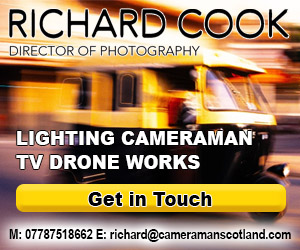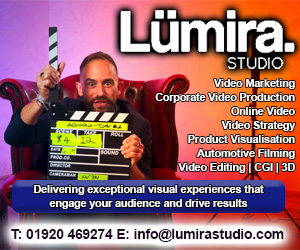Broadcast News
31/10/2012
Jigsaw 24 -Working With The Blackmagic Design Cinema Camera: The Workflow -Part 2
So where does the Cinema Camera belong?
James: I believe the BMCC has a natural place in high end film, commercial and music shoots. Its only limitations for me at present are a lack of higher frame rates but from an image, production and post-production workflow point of view, the camera is very well suited for professional jobs.
Den: This is something James and I were talking about last night, how we'd love to shoot another gig like Duran Duran using these cameras. I don't think there's anything I wouldn't use it on, because so far I'm so happy with the images that have come back from all the beta testers and the workflow works, so there's no real reason why I wouldn't use it. John Brawley's been shooting a series in Australia called Puberty Blues and he's been using Alexas and REDs and this camera, so I think speaking to DPs who have been using it on big productions and been happy with it, if I'm happy with it and James is happy with it and Phil Bloom's happy with it, and everyone else is really happy, then there's this peer group of professionals I respect and no-one's saying, "I think this is a bit of a problem...", so I'd be happy taking it into any environment. I think one area where I haven't pushed it is in really extreme low light, like in concerts, so I think I'd like to do that at some point and see how it performs there.
James: Any application of high speed cinematography is certainly something the BMCC is currently unsuited for. It is also perhaps not the strongest for very, very low lighting situations as I believe the camera performs better when exposed with more rather than less light. Lastly, the camera is intended as a professional tool. Yes, you could film family holidays with it, but the current price of SSDs, need for professional powering solutions and an advanced post workflow for RAW set it apart from lower priced 'point and shoot' video or DSLR cameras.
Den: I think what's important to consider is you can't buy one camera that will do everything. The Cinema Camera is not appropriate for every job. If you're doing something that's just for the web, depending on the job, I might shoot on the FS100, because the additional time in post does cost the business money, so the budget for the project needs to be there to justify the extra time in post.
Key considerations
James: The first consideration is picking the right choice of lenses so that you can still cover a wide focal range, i.e. choosing either a Sigma 8-16mm or Tokina 11-16mm for the wide end. The second choice is how to power the camera in combination with the type of shooting style and configuration, i.e. shoulder mount with larger IDX, Anton batteries, or handheld using smaller powering solutions from companies like Hawk-Woods. The camera's recording formats are flexible enough for it to be used in many applications, such as sticking with ProRes/DNxHD for long form work (documentary, live events, etc.) or choosing RAW for shorter form work with a greater post budget (commercials, narrative drama/film). I believe that aside from lacking in higher frame rates, the camera is a very flexible device and will no doubt find itself on a multitude of different jobs and applications that even Blackmagic haven't imagined yet.
CU Sigma on BMCCDen: Make sure you budget for your accessories. You've got to factor in sometimes more money than the camera for accessories that mean you're comfortable using it for long periods of time. Remember power distribution, some sort of EVF and some sort of rig, and a tripod that can handle the payload. There's no point in having all this camera and this wonderful process if you've got a crappy tripod.
Choosing your accessories
Den: What I've found to be the most important accessory at the moment is power distribution. I've got a bebob cage with a V-Lock battery plate with four high-res outputs and two D-tap outputs. I've got that powered up and I can power an on-board monitor, I can power an EVF, I can power up a light if I want to and that's been the most important thing so far.
James: Without doubt the most important accessory is a means to power the camera over an extended shooting period. Hawk-Woods came to my aid early on by developing a battery mount for Sony NPF batteries which allows the camera to be powered as well as recharging the internal battery at the same time. As the camera can take between a 12-30V input this makes it very flexible in terms of how you can power it, however I really like its small portable size and hence why the Hawk-Woods solutions have been ideal for me in keeping the camera size small.
The second most important accessory is then either a variable neutral density filter or matte box to help control exposure when shooting wide open on the lens. The sensor has a natural rating of 800 ASA, and hence it's important to control exposure with filters to compensate, after all this is called a 'cinema' camera, and as such built-in NDs are not included.
Top tips for new users
James: New users of the camera should get out and test shoot with it to gain a good idea of its exposure latitude and how to get the best image from it. Unlike most of the cameras in its league, the Cinema Camera works best with more light than less, or exposing to the right as it's sometimes called. Other digital camera formats differ in that if clipped, the highlights are not recoverable and as such it's safer to under expose and pull the mids up. I've found that the BMCC can hold incredible amounts of information in the highlights, even when over-exposed, whereas it can get noisier quicker in the mids if under exposed. Testing and getting used to the images and the latitude you have in the grade is the best starting point for anyone picking up the camera for the first time.
Den: You have to remember how much more power you're getting when you're dealing with a 12-bit RAW image. You've got to make sure your machine is up to spec to handle Resolve, and have a decent graphics card so you can handle the extra processing involved. And get some training! Make sure that you understand. We're putting together a specific training programme for new users because it can trip you up. There are a lot of extra steps involved in a RAW workflow, but when you do get it right it's such an exciting and a stunning finish that you get because you have all this extra data, that it's very much worth it.
www.jigsawbroadcast.com
James: I believe the BMCC has a natural place in high end film, commercial and music shoots. Its only limitations for me at present are a lack of higher frame rates but from an image, production and post-production workflow point of view, the camera is very well suited for professional jobs.
Den: This is something James and I were talking about last night, how we'd love to shoot another gig like Duran Duran using these cameras. I don't think there's anything I wouldn't use it on, because so far I'm so happy with the images that have come back from all the beta testers and the workflow works, so there's no real reason why I wouldn't use it. John Brawley's been shooting a series in Australia called Puberty Blues and he's been using Alexas and REDs and this camera, so I think speaking to DPs who have been using it on big productions and been happy with it, if I'm happy with it and James is happy with it and Phil Bloom's happy with it, and everyone else is really happy, then there's this peer group of professionals I respect and no-one's saying, "I think this is a bit of a problem...", so I'd be happy taking it into any environment. I think one area where I haven't pushed it is in really extreme low light, like in concerts, so I think I'd like to do that at some point and see how it performs there.
James: Any application of high speed cinematography is certainly something the BMCC is currently unsuited for. It is also perhaps not the strongest for very, very low lighting situations as I believe the camera performs better when exposed with more rather than less light. Lastly, the camera is intended as a professional tool. Yes, you could film family holidays with it, but the current price of SSDs, need for professional powering solutions and an advanced post workflow for RAW set it apart from lower priced 'point and shoot' video or DSLR cameras.
Den: I think what's important to consider is you can't buy one camera that will do everything. The Cinema Camera is not appropriate for every job. If you're doing something that's just for the web, depending on the job, I might shoot on the FS100, because the additional time in post does cost the business money, so the budget for the project needs to be there to justify the extra time in post.
Key considerations
James: The first consideration is picking the right choice of lenses so that you can still cover a wide focal range, i.e. choosing either a Sigma 8-16mm or Tokina 11-16mm for the wide end. The second choice is how to power the camera in combination with the type of shooting style and configuration, i.e. shoulder mount with larger IDX, Anton batteries, or handheld using smaller powering solutions from companies like Hawk-Woods. The camera's recording formats are flexible enough for it to be used in many applications, such as sticking with ProRes/DNxHD for long form work (documentary, live events, etc.) or choosing RAW for shorter form work with a greater post budget (commercials, narrative drama/film). I believe that aside from lacking in higher frame rates, the camera is a very flexible device and will no doubt find itself on a multitude of different jobs and applications that even Blackmagic haven't imagined yet.
CU Sigma on BMCCDen: Make sure you budget for your accessories. You've got to factor in sometimes more money than the camera for accessories that mean you're comfortable using it for long periods of time. Remember power distribution, some sort of EVF and some sort of rig, and a tripod that can handle the payload. There's no point in having all this camera and this wonderful process if you've got a crappy tripod.
Choosing your accessories
Den: What I've found to be the most important accessory at the moment is power distribution. I've got a bebob cage with a V-Lock battery plate with four high-res outputs and two D-tap outputs. I've got that powered up and I can power an on-board monitor, I can power an EVF, I can power up a light if I want to and that's been the most important thing so far.
James: Without doubt the most important accessory is a means to power the camera over an extended shooting period. Hawk-Woods came to my aid early on by developing a battery mount for Sony NPF batteries which allows the camera to be powered as well as recharging the internal battery at the same time. As the camera can take between a 12-30V input this makes it very flexible in terms of how you can power it, however I really like its small portable size and hence why the Hawk-Woods solutions have been ideal for me in keeping the camera size small.
The second most important accessory is then either a variable neutral density filter or matte box to help control exposure when shooting wide open on the lens. The sensor has a natural rating of 800 ASA, and hence it's important to control exposure with filters to compensate, after all this is called a 'cinema' camera, and as such built-in NDs are not included.
Top tips for new users
James: New users of the camera should get out and test shoot with it to gain a good idea of its exposure latitude and how to get the best image from it. Unlike most of the cameras in its league, the Cinema Camera works best with more light than less, or exposing to the right as it's sometimes called. Other digital camera formats differ in that if clipped, the highlights are not recoverable and as such it's safer to under expose and pull the mids up. I've found that the BMCC can hold incredible amounts of information in the highlights, even when over-exposed, whereas it can get noisier quicker in the mids if under exposed. Testing and getting used to the images and the latitude you have in the grade is the best starting point for anyone picking up the camera for the first time.
Den: You have to remember how much more power you're getting when you're dealing with a 12-bit RAW image. You've got to make sure your machine is up to spec to handle Resolve, and have a decent graphics card so you can handle the extra processing involved. And get some training! Make sure that you understand. We're putting together a specific training programme for new users because it can trip you up. There are a lot of extra steps involved in a RAW workflow, but when you do get it right it's such an exciting and a stunning finish that you get because you have all this extra data, that it's very much worth it.
www.jigsawbroadcast.com
Top Related Stories
Click here for the latest broadcast news stories.
28/02/2024
Lifesize Plans Teams Up With Panasonic And Think
Lifesize Plans has partnered with Panasonic and Dublin-based AV specialists, Think, to install 11 PT-RTZ990 1-Chip DLP™ projectors across its showroom
Lifesize Plans Teams Up With Panasonic And Think
Lifesize Plans has partnered with Panasonic and Dublin-based AV specialists, Think, to install 11 PT-RTZ990 1-Chip DLP™ projectors across its showroom
02/06/2023
Wooden Camera Launches New Elite Accessory Camera System
Wooden Camera has announced the new Elite Accessory System for ARRI ALEXA 35: a series of camera cage components designed to provide a flexible, full-
Wooden Camera Launches New Elite Accessory Camera System
Wooden Camera has announced the new Elite Accessory System for ARRI ALEXA 35: a series of camera cage components designed to provide a flexible, full-
07/12/2023
Videosys Broadcast Announces New Features For Its Camera Control Products
Videosys Broadcast has announced a range of new features for its camera control products including its flagship Epsilon 4K base station Camera Control
Videosys Broadcast Announces New Features For Its Camera Control Products
Videosys Broadcast has announced a range of new features for its camera control products including its flagship Epsilon 4K base station Camera Control
07/11/2023
Marshall Electronics Unveils Its CV630-NDIW 30X UHD PTZ Camera
Marshall Electronics has announced its new CV630-NDIW 30X UHD PTZ camera with NDI®|HX2. The CV630-NDIW is ideal for use in live newscasts, concerts, r
Marshall Electronics Unveils Its CV630-NDIW 30X UHD PTZ Camera
Marshall Electronics has announced its new CV630-NDIW 30X UHD PTZ camera with NDI®|HX2. The CV630-NDIW is ideal for use in live newscasts, concerts, r
19/06/2023
Matthews Offers Better Way To Level Up Camera Rigging
Matthews now offers a better way to level up camera rigging with the latest addition to the patented Infinity Arm system. The new interchangeable ARRI
Matthews Offers Better Way To Level Up Camera Rigging
Matthews now offers a better way to level up camera rigging with the latest addition to the patented Infinity Arm system. The new interchangeable ARRI
30/10/2012
Jigsaw24 - Working With The Blackmagic Design Cinema Camera: The Camera
Jigsaw24 - Working With The Blackmagic Design Cinema Camera: The Camera - Part 1 By Liz Sunter While we've not been shy about getting grabby with the
Jigsaw24 - Working With The Blackmagic Design Cinema Camera: The Camera
Jigsaw24 - Working With The Blackmagic Design Cinema Camera: The Camera - Part 1 By Liz Sunter While we've not been shy about getting grabby with the
15/04/2024
Ikegami USA To Introduce New Additions To Its Broadcast-Quality Production Equipment
Celebrating its 60th Anniversary this year, Ikegami USA will introduce four new additions to its range of broadcast-quality production equipment at th
Ikegami USA To Introduce New Additions To Its Broadcast-Quality Production Equipment
Celebrating its 60th Anniversary this year, Ikegami USA will introduce four new additions to its range of broadcast-quality production equipment at th
10/04/2024
ARRI Announces ALEXA 35 Live - Multicam System
ARRI has announced the ALEXA 35 Live - Multicam System, making the cinematic image quality of its flagship ALEXA 35 camera available to the world of l
ARRI Announces ALEXA 35 Live - Multicam System
ARRI has announced the ALEXA 35 Live - Multicam System, making the cinematic image quality of its flagship ALEXA 35 camera available to the world of l
13/03/2012
Vitec GTC Awards 2012 Nominees Announced
The Guild of Television Cameramen (GTC) has announced the shortlist for the Vitec GTC Awards 2012. The awards will be presented at the IET Austin Cour
Vitec GTC Awards 2012 Nominees Announced
The Guild of Television Cameramen (GTC) has announced the shortlist for the Vitec GTC Awards 2012. The awards will be presented at the IET Austin Cour
17/04/2024
Grass Valley Unveils New Camera Solutions
Grass Valley has unveiled its new LDX 135 RF and LDX 150 RF camera solutions at NAB Show 2024, providing the same leading camera technology as their s
Grass Valley Unveils New Camera Solutions
Grass Valley has unveiled its new LDX 135 RF and LDX 150 RF camera solutions at NAB Show 2024, providing the same leading camera technology as their s
09/04/2024
Telycam Announces Shipping Of The Explore SE PTX Camera
Telycam has announced the official shipping of its latest technological advancement, the Explore SE PTZ camera. Positioned as a frontrunner in the fie
Telycam Announces Shipping Of The Explore SE PTX Camera
Telycam has announced the official shipping of its latest technological advancement, the Explore SE PTZ camera. Positioned as a frontrunner in the fie
01/02/2024
Ikegami Delivers Camera Systems To Iberian Public Service Television Network
Ikegami Electronics has announced the delivery of 27 UHK-X700 4K-UHD HDR camera systems to a leading Iberian public service television network. The pr
Ikegami Delivers Camera Systems To Iberian Public Service Television Network
Ikegami Electronics has announced the delivery of 27 UHK-X700 4K-UHD HDR camera systems to a leading Iberian public service television network. The pr
12/01/2024
Telycam To Display Explore SE PTZ Camera
Telycam is to take part in the Integrated Systems Europe (ISE) 2024 exhibition. The company will be showcasing its state-of-the-art Explore SE PTZ cam
Telycam To Display Explore SE PTZ Camera
Telycam is to take part in the Integrated Systems Europe (ISE) 2024 exhibition. The company will be showcasing its state-of-the-art Explore SE PTZ cam
10/01/2024
Marshall Electronics Releases Its VS-PTC-300 PTZ Camera Controller
Marshall Electronics has released its VS-PTC-300 PTZ camera controller, providing the ability to manage multiple protocols, including NDI, RS232/RS422
Marshall Electronics Releases Its VS-PTC-300 PTZ Camera Controller
Marshall Electronics has released its VS-PTC-300 PTZ camera controller, providing the ability to manage multiple protocols, including NDI, RS232/RS422
19/12/2023
Camera Corps' Basecam Approved By Major Baseball League
Camera Corps has secured a groundbreaking collaboration with the Major Baseball League(MBA) and the approval of its cutting-edge Basecam. The Basecam,
Camera Corps' Basecam Approved By Major Baseball League
Camera Corps has secured a groundbreaking collaboration with the Major Baseball League(MBA) and the approval of its cutting-edge Basecam. The Basecam,















